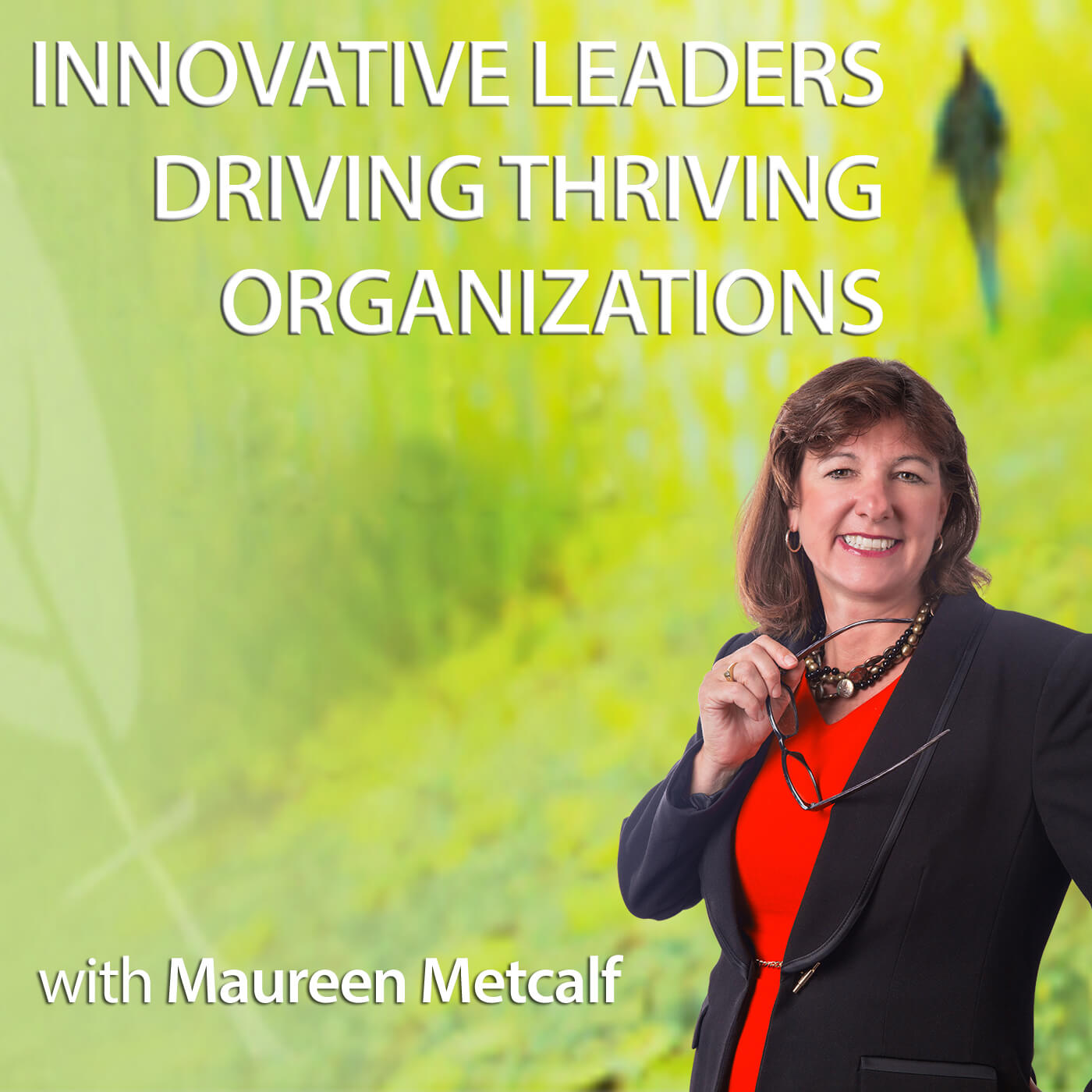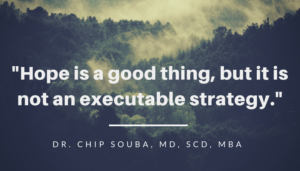This blog was written as a companion to the VoiceAmerica Interview with Dr. Wiley “Chip” Souba, MD, ScD, MBA on August 15, Physician Leadership, Flipping the Leadership Paradigm. This blog is the forward written by Dr. Souba for the Innovative Leadership Workbook for Physician Leaders.
By any objective measure, the amount of painful, gut-wrenching change in health care continues to increase. Transformational change is always traumatic because in the process of taking it on, each of us must, in a very real sense, reinvent ourselves. We must change our assumptions, our cognitive frameworks, our ways of being and acting, and our ways of collaborating with one another. Jettisoning our familiar practices that are holding us back may make sense intellectually but rewiring the neural networks that underpin these habits can be overwhelming. It is no wonder that we don’t greet change with open arms. Understandably, we avoid significant change like the plague.
Avoidance, however, is no longer an option. Intense pressure from powerful stakeholders – big business, patients, legislators, and payers – is driving the healthcare transformation imperative. This leaves us with three options. We can choose to disengage, arguing that the health care conundrum is too complex to tackle, not our problem, and certainly not our fault. In so doing, we shortchange the future of our children and most Americans. Secondly, we could decide to continue pounding away, hoping for a future that is a continuation of the past. Hope is a good thing but it is not an executable strategy.1 Lastly, we can choose to revise the way in which we think about (make sense of) these challenges, and more specifically, revise the way in which we develop physicians who are more effective leaders going forward. Until and unless we re-language (reframe) our challenges, we will not alter, in any kind of meaningful way, our results.
How do we shift our thinking when the shackles of our long-standing cognitive maps are so entrenched and hidden? This workbook offers several assessments, tools, and practices to help you, as a leader, begin to examine your thinking and identify areas where you may need to transcend your current practices. While this process is not an easy one – it invites you to change how you see yourself in the world – it is an important part of developing yourself as a physician leader in a complex and convoluted environment.
Creating Leaders
Teaching people about leadership is different from creating leaders.2 Teaching leadership uses a third-person approach to impart someone else’s knowledge, which grants learners limited access to the being and actions of effective leaders. In contrast, creating leaders requires a first-person methodology, which provides direct access to what it means to be a leader and what it means to exercise good leadership in real time, with real results. Many health care transformation efforts run amuck because they overlook this distinction. This workbook emphasizes the inner work of leading oneself as well as the outer process of connecting personal values and actions to the organization’s culture. Leaders use the innovative leadership framework to learn what it is to be a leader and what it means to exercise leadership behaviors effectively by making use of a model that distinguishes being a leader as the foundation for the leader’s actions.
Why is the being of leadership foundational? Simply, because if you’re not being a leader, it is impossible to act like a leader.3 Because our understanding of what it means to be – a physician, a medical student, a researcher, a leader – is changing, a more effective approach to developing leaders starts with four pillars of being a leader – awareness, commitment, integrity, and authenticity – as the ontological foundation for what leaders know and do.4 This way of understanding leadership is core to the basic tenets of professionalism. The workbook will walk you through a series of self-assessments and reflection questions to increase your level of conscious awareness. You will build a development plan and enlist a support group in helping you meet your goals thereby creating an implicit commitment to yourself and to your team. The exercises and reflection questions invite you to examine what you believe and how those beliefs impact your actions. When they are not aligned, you will identify the misalignments and have the opportunity to bring your actions into integrity with your beliefs and to act in ways that are authentic.
Accessing Leadership
When we think of the word “access,” it tends to bring to mind the notion of making something available so as to utilize it, apply it, or take advantage of it (e.g., our bank account, the internet, the patient’s medical record). The idea that leadership is something we access may seem odd as we generally think of leadership as an ability that people just have or don’t have. However, when we recognize that leadership is about expanding our range of ways of being, thinking, and behaving so we can be more effective in dealing with those challenges for which conventional strategies are inadequate, the notion of access makes more sense.5 Without the ability to access new ways of being and acting, we will default to what is comfortable whenever we are called to take on a major leadership challenge and our results will be mediocre at best. The innovative leadership framework in this workbook combines personality-type tools to help you understand your innate inclinations and how they impact your leadership capabilities. The framework also includes a developmental perspective that looks at how you make meaning of the world. It is this meaning-making process that matures through a series of stages that increases your capacity as a leader. The workbook is designed to help you as a leader identify your current competence and build it, thereby giving you greater access to your personal leadership capacity.
Access to leadership occurs primarily through first-person and third-person approaches, although the former tends to be disregarded. Observing leaders – and then describing, measuring, and categorizing their behaviors and traits – uses a third-person methodology. This third-person approach to studying leadership, which emphasizes what leaders know, have, and do, is theoretical and inferential but continues to be the most common leadership pedagogy.2 Theories, explanations, and textbooks provide us with third-person access to leadership, but, in and of themselves, they do not impart what is required to be a leader, much as textbooks do not teach what it is to be a physician.
Rather than teaching leadership from a theoretical (third-person) vantage point, the first-person perspective teaches leadership as it is experienced. It is important to recognize that you and I do not lead from a theoretical standpoint; rather, we lead moment-to-moment, situation-to-situation in the way we experience leadership “as lived,” that is, from a first-person point of view.6 Such subjective experiences (first-person data) cannot be described using a third-person perspective. The distinctiveness of the first-person “as-lived/lived-through” approach lies in its capacity to disclose the hidden contexts that shape the ways of being, thinking, and acting that are the source of the leader’s performance.2 When one exercises leadership “as lived,” concurrently informed by theories, one tends to be in one’s “A” game. When using this workbook, you will be directly engaging in leadership development activities and reflection practices. This workbook is an attempt to integrate first-person and third-person learning. The first two chapters focus on the third-person theoretical frameworks of innovative leadership and physician leadership competencies. The book then shifts from third-person to first-person perspective as it asks you, as the leader, to complete a series of worksheets and reflection questions that explore yourself as an authentic person. You will explore your personal vision and values then develop a plan that helps you build yourself into the leader who can bring that vision into the world in a manner that is consistent with your values. The majority of the book is designed to lead you through an interactive process that helps you have the first-hand experience of yourself being a leader.
In order to gain access to more effective ways of leading, we must first expose our engrained beliefs and worldviews about leadership (e.g., I can’t look incompetent, I need to be right, I must have the answers) that are limiting us. This will allow us to relax those limiting (and often veiled) ways of being and acting that have become our automatic go-to formulas (e.g., making excuses, not holding ourselves and others accountable, blaming others) that actually constrain our freedom to lead.4 By probing this space you will explore your worldviews in general and your leadership presuppositions specifically. The authors recommend you take the MAP assessment to determine your worldview along with other assessments that help you determine your personality type and leadership behaviors. The combination of tools will give you a comprehensive view of who you are and what you do.
About the Author
Dr. Wiley “Chip” Souba MD, ScD, MBA has been Vice President for Health Affairs at Dartmouth College and as Dean of Dartmouth Medical School since October 1, 2010. Dr. Souba served as Dean of the College of Medicine and as Vice President and Executive Dean of Health Sciences at The Ohio State University.
References
1. Souba W. Brock Starr: a leadership fable. Journal of Surgical Research. 2009. 155: 1-6.
2. Souba W. The phenomenology of leadership. Open Journal of Leadership. In press.
3. Souba W. The science of leading yourself: A missing piece in the healthcare reform puzzle. Open Journal of Leadership 2013; 2 (3): 45–55.
4. Souba W. The being of leadership. Philosophy, Ethics, and Humanities in Medicine 2011; 6 (5). Available at http://www.ncbi.nlm.nih.gov/pmc/articles/PMC3050817/







